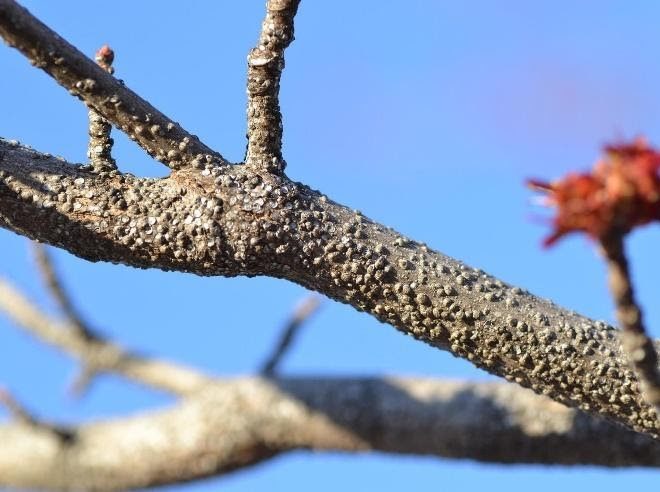CALL TO MEET WITH AN ARBORIST
704.525.3066 Charlotte
828.231.6008 Asheville
704.892.8927 Lake Norman
Armored Scales
Trees and Shrubs at risk – Many of our common landscape trees and shrubs are susceptible to armored
scale insects. The list includes but is not limited to: Maples, Serviceberry, Camellia, Hawthorn, Red Bud,
Yellowwood, Dogwoods, Cotoneaster, Euonymus, Ash, Locust, Holly, Privet, Magnolia, Crabapples,
Plum, Pyracantha, Pears, Willow, Styrax, Lindens, Elms, Zelkova and others.
Common Armored Scales in our region
Tea Scale on Camellia (underside of leaf)

Gloomy scale on Maple

Japanese Maple scale on Maple

White Prunicola Scale on Laurel

Signs and Symptoms:
These can vary widely depending on the type of scale and the type of host plant. Signs and symptoms range from discoloration of foliage on Camellia and Holly from tea scale, stunting and limb dieback on
Maple from japanese maple or gloomy scale all the way to total plant decline as often happens with Euonymus and Laurels attacked by euonymus and white prunicola scales respectively.

Treatment Strategy:
Armored scales can be very difficult to manage after populations are established. Control can not always be expected quickly, depending on the species and severity of infestation. Some infestations may take two to three seasons or more to get under control. A three-pronged approach is recommended, so that all life stages of tea scale may be addressed. A full program greatly improves the chances of this not becoming a chronic issue.
Early detection is critical for best management of infested trees. Monitor three to four year old twigs for the white and gray protective covers of this armored scale insect. Heavily infested branches should be pruned and destroyed. Treatment strategies and timing varies slightly depending on which variety of scale is being targeted. The most effective treatment strategies will include a three part treatment schedule.
- Adults can be targeted through most of the growing season with a systemic application, ideally late-spring or early-summer. This protects the tree from the inside out for a limited amount of time, killing any pest feeding on the tree. This application may not fully protect against crawlers maturing in late summer.
- Crawlers can be targeted with an insect growth regulator. Insect growth regulators disrupt insect development, preventing younger life stages from developing into adults.
- Overwintering eggs should be addressed with a dormant oil spray. Dormant oil smothers the eggs. A dormant oil spray should be applied in winter during the period after leaf drop and before bud break to prevent reemergence.
Whenever possible beneficial insect releases will be made to help reduce reliance on pesticides and help control the pests naturally. Please note that even after control is achieved the scale insect bodies can remain on their host for several more seasons.
GET LIVE UPDATES FROM HEARTWOOD TREE
Stay current with the updates, newsletter and our event schedule. We are passionate about increasing awareness about the diminishing canopy coverage of our planet and we’re always staying involved to continue to be a part of the solution.

